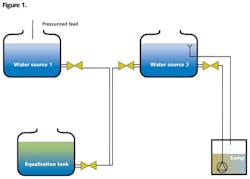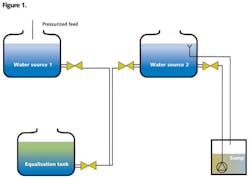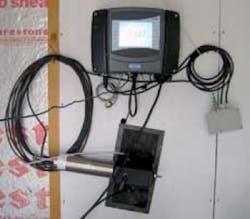Measuring levels of oil in water (OIW) has long been a challenging prospect due to the variability of the material being analyzed and the measurement media. The oil, depending on its components, can vary widely in its solubility in water, and can create emulsions of highly variable droplet sizes. This variability depends largely on the applications where the water is used and the challenge is greatest where on-line analysis is implemented.
A significant challenge in applying methods other than laboratory analysis is to prove correlation between the oil concentration and the instrument readings when it is applicable. In the majority of cases, the detection of contamination when it exceeds some tolerable or regulatory threshold is sufficient.
In a recent project, a UV-fluorescent sensor sensitive to polycyclic aromatic hydrocarbons (PAH) was tested on a heat exchanger at a gas manufacturing plant. The sensor response to an oil leak was found to be fast and significant.
The tested Hach FP 360 sc sensor is attuned to fluorescence PAHs commonly present in petroleum oils, which are mostly derivatives of naphthalene, anthracene, and phenanthrene. Their common structural feature is a system of conjugate bonds that give them fluorescent properties.
The Linde Industrial Gases facility in southwestern Colorado was selected as the test site because plant personnel were concerned with frequent leaks of heat transfer fluid to the cooling water, which caused a problem once the oil exceeded a 10-ppm threshold. These leaks would contaminate water in the heat exchanger with oil, making it impossible to use it for cooling purposes. Problems created by such leaks range from a relatively minor inconvenience and cleanup to a significant, costly incident leading to a complete plant shutdown and thousands of dollars of losses.
Monitoring System
The Hach FP 360 sc sensor (0-5000 ppb, with titanium housing) was used to monitor a sample feed from the water outlet of a heat exchanger. The system was installed in a shed harboring the chemical feed system for corrosion control near the cooling tower.
The sample feed was provided with a flow cell. The system was installed in a shed harboring the chemical feed system for corrosion control near the cooling tower.
The probe was connected to an sc-controller, which was equipped with a relay card able to send an analog signal to either the central monitoring post or to display an alarm locally in the case of exceeding the prescribed OIW level.
The other opportunity for remote access and control was a wireless communication option enabled through Global Packet Radio Service (GPRS) provided by most cell phone companies. Unfortunately, due to the test site’s remote location, no such service was available.
Critical Incident
After several days of normal operation, with readings close to zero, an oil leak from the heat exchanger into the cooling tower water was detected. Over a matter of minutes, the probe recorded data showing the oil in water level going from zero to 100 percent (relative scale). This instantaneous reaction of the sensor to the leak helped plant personnel begin countermeasures fairly quickly to prevent a larger scale accident. The contamination cost totaled more than $1,000 in lost oil; however, this could have been much higher if no early detection was in place.
In addition to the lost oil, the company had to clean the contaminated cooling water using an extra biocide, oil-absorbing mats, higher chlorine post injection, draining the entire cooling tower, and then re-establishing chlorine and polymer levels in the cooling water. All of this cost approximately $1,000 including eight hours of labor and clean-up supplies.
Instrument Details
The Hach FP 360 sc is a new approach to tackling the particular challenge of detecting oil in water over a broad range of concentrations. As with any process instrument, the probe reduces the frequency of laboratory analyses. One of the major benefits of the probe design is the ability to place the instrument almost anywhere, while UV-fluorescence technology provides for high sensitivity and specificity of the OIW analyses.
The probe, designed for in-situ measurement, has no moving parts or pumps to maintain. Maintenance is limited to simply wiping the sensor’s measurement window periodically, calibrating its electronics once every two years, and replacing its xenon lamp once every four years. A cleaning unit is available for applications with low flow where the potential for fouling is significant.
For example, when the sensor is submersed in a slow-moving, dirty sample, cleaning may be necessary daily or even more often, depending on the sample conditions and its origin. For submersible installations, the cleaning can be done in situ, as necessary, when the probe has an optional automatic air blast cleaning system that is manageable from the same controller.
In the case of the flow cell and sample pre-filtering, maintenance may consist of nothing other than occasional cleaning of the strainer installed in the sample line feeding the flow cell. In fact, at the Cortez plant, there was no maintenance conducted on the sensor during more than 45 days of testing.
“For us, the sensor proved to be maintenance-free – we never had to do anything during the operation,” said Jerrod Hughes, operations tech at the facility.




